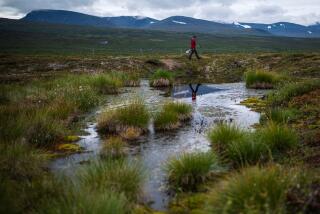Sunlight stimulates release of carbon dioxide in melting permafrost
- Share via
Ancient plant and animal matter trapped within Arctic permafrost can be converted rapidly into climate-warming carbon dioxide when melted and exposed to sunlight, according to a new study.
In a report published Monday in the Proceedings of the National Academy of Sciences, a team of environmental and biological scientists examined 27 melting permafrost sites in Alaska and found that bacteria converted dissolved organic carbon materials into the greenhouse gas CO2 40% faster when exposed to ultraviolet light.
Study authors said that while it remained unclear just how much CO2 would be released as Arctic permafrost continues to melt, the findings were cause for concern. High latitude soils currently store twice the amount of carbon than is found in the atmosphere.
“What we can say now is that regardless of how fast the thawing of the Arctic permafrost occurs, the conversion of this soil carbon to carbon dioxide and its release into the atmosphere will be faster than we previously thought,” senior author George Kling, a University of Michigan ecologist and aquatic biogeochemist, said in a statement.
“That means permafrost carbon is potentially a huge factor that will help determine how fast the Earth warms,” Kling said.
Plant and animal matter has remained locked in frozen Arctic soils for thousands of years. When those soils begin to thaw, however, the organic matter begins to decay. As that matter decays, it is eaten by microbes, which produce either methane or CO2 as a byproduct. Methane -- an even more powerful greenhouse gas than CO2 -- occurs when the decaying matter is not exposed to oxygen.
Study authors examined melt water in so-called thermokarst impacted areas. Thermokarsts occur when long-frozen earth melts and the soil collapses into a sink-hole or causes a landslide.
As the permafrost melts, organic matter is dissolved in the melt water and exposed to sunlight in streams or pools.
Authors found that the rate of CO2 conversion slowed at night, or during cloudy conditions.
“Although no estimates exist for what percentage of now-frozen carbon will be released to the surface as the Arctic warms, the alteration and fate of this carbon will depend on its susceptibility to coupled photobiological processing and the available light,” wrote study lead author Rose Cory, an assistant professor of environmental sciences and engineering at the University of North Carolina.
Return to Science Now blog.
Follow me on Twitter @montemorin







